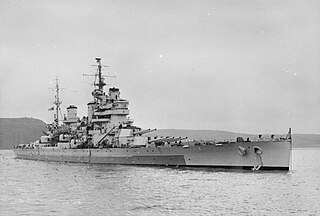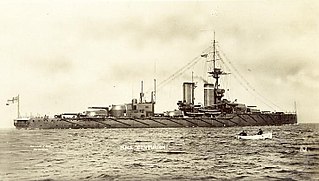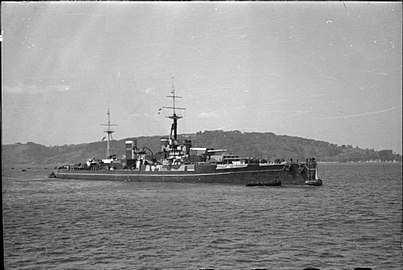
Giulio Cesare was one of three Conte di Cavour-class dreadnought battleships built for the Royal Italian Navy in the 1910s. Completed in 1914, she was little used and saw no combat during the First World War. The ship supported operations during the Corfu Incident in 1923 and spent much of the rest of the decade in reserve. She was rebuilt between 1933 and 1937 with more powerful guns, additional armor and considerably more speed than before.

HMNZS Achilles was a Leander-class light cruiser, the second of five in the class. She served in the Royal New Zealand Navy in the Second World War. She was launched in 1931 for the Royal Navy, loaned to New Zealand in 1936 and transferred to the new Royal New Zealand Navy in 1941. She became famous for her part in the Battle of the River Plate, alongside HMS Ajax and HMS Exeter and notable for being the first Royal Navy cruiser to have fire control radar, with the installation of the New Zealand-made SS1 fire-control radar in June 1940.

HMS Hermes was a British aircraft carrier built for the Royal Navy and was the world's first ship to be designed as an aircraft carrier, although the Imperial Japanese Navy's Hōshō was the first to be launched and commissioned. The ship's construction began during the First World War, but she was not completed until after the end of the war, having been delayed by multiple changes in her design after she was laid down. After she was launched, the Armstrong Whitworth shipyard which built her closed, and her fitting out was suspended. Most of the changes made were to optimise her design, in light of the results of experiments with operational carriers.

HMS Anson was a King George V-class battleship of the Royal Navy, named after Admiral George Anson. She was built by Swan Hunter and Wigham Richardson Shipyard and launched on 24 February 1940, being completed on 22 June 1942. Her completion was delayed to allow the fitting of fire-control radar and additional anti-aircraft weapons. She was originally to have been named Jellicoe, but was renamed Anson in February 1940.

HMS Revenge was the lead ship of five Revenge-class super-dreadnought battleships built for the Royal Navy during the First World War in the mid-1910s. The ships were developments of the Queen Elizabeth-class battleships, with reductions in size and speed to offset increases in armour protection whilst retaining the same main battery of eight 15-inch (381 mm) guns. She was laid down in 1913, launched in 1915 and commissioned in February 1916, early enough to be worked up to see action with the Grand Fleet at the Battle of Jutland in May that year. During the engagement, she engaged German battlecruisers, damaging two of them before being forced to turn away to avoid torpedoes that damaged her squadron flagship and caused the squadron to lose contact with the rest of the fleet. Revenge emerged from the battle unscathed, but she saw no further action during the war, as the British and German fleets turned to more cautious strategies owing to the risk of submarines and naval mines.

HMS Royal Sovereign was a Revenge-class battleship of the Royal Navy displacing 29,970 long tons (30,450 t) and armed with eight 15-inch (381 mm) guns in four twin-gun turrets. She was laid down in January 1914 and launched in April 1915; she was completed in May 1916, but was not ready for service in time to participate in the Battle of Jutland at the end of the month. She served with the Grand Fleet for the remainder of the First World War, but did not see action. In the early 1930s, she was assigned to the Mediterranean Fleet and based in Malta.

HMS Queen Elizabeth was the lead ship of her class of five dreadnought battleships built for the Royal Navy in the early 1910s, and was often used as a flagship. She served in the First World War as part of the Grand Fleet, and participated in the inconclusive action of 19 August 1916. Her service during the war generally consisted of routine patrols and training in the North Sea. She and the other super-dreadnought battleships were the first of their type to be powered by oil instead of coal. Queen Elizabeth later served in several theatres during the Second World War, and was ultimately scrapped in 1948.

HMS Valiant was one of five Queen Elizabeth-class battleships built for the Royal Navy during the early 1910s. She participated in the Battle of Jutland during the First World War as part of the Grand Fleet. Other than that battle, and the inconclusive Action of 19 August, her service during the war generally consisted of routine patrols and training in the North Sea. She saw further action during the Second World War in the Mediterranean and Far East.

HMS Malaya was one of five Queen Elizabeth-class battleships built for the Royal Navy during the 1910s. Shortly after commissioning in early 1916, she participated in the Battle of Jutland as part of the Grand Fleet. Other than that battle, and the inconclusive Action of 19 August, her service during the First World War mostly consisted of routine patrols and training in the North Sea.

HMS Renown was the lead ship of her class of battlecruisers of the Royal Navy built during the First World War. She was originally laid down as an improved version of the Revenge-class battleships. Her construction was suspended on the outbreak of war on the grounds she would not be ready in a timely manner. Admiral Lord Fisher, upon becoming First Sea Lord, gained approval to restart her construction as a battlecruiser that could be built and enter service quickly. The Director of Naval Construction (DNC), Eustace Tennyson-D'Eyncourt, quickly produced an entirely new design to meet Admiral Lord Fisher's requirements and the builders agreed to deliver the ships in 15 months. They did not quite meet that ambitious goal, but the ship was delivered a few months after the Battle of Jutland in 1916. Renown, and her sister HMS Repulse, were the world's fastest capital ships upon completion.

HMS Repulse was one of two Renown-class battlecruisers built for the Royal Navy during the First World War. Originally laid down as an improved version of the Revenge-class battleship, her construction was suspended on the outbreak of war because she would not be ready in time. Admiral Lord Fisher, upon becoming First Sea Lord, gained approval for her to resume construction as a battlecruiser that could be built and enter service quickly. The Director of Naval Construction (DNC), Eustace Tennyson-d'Eyncourt, quickly produced an entirely new design to meet Admiral Lord Fisher's requirements and the builders agreed to deliver the ship in 15 months. They did not quite meet that ambitious goal, but the ship was delivered a few months after the Battle of Jutland in 1916. Repulse and her sister ship Renown, were the world's fastest capital ships upon completion.

The King George V-class battleships were a group of four dreadnought battleships built for the Royal Navy (RN) in the early 1910s that were sometimes termed super-dreadnoughts. The sister ships spent most of their careers assigned to the 2nd Battle Squadron of the Home and Grand Fleets, sometimes serving as flagships. In October 1914, Audacious struck a mine and sank. Aside from participating in the failed attempt to intercept the German ships that had bombarded Scarborough, Hartlepool and Whitby in late 1914, the Battle of Jutland in May 1916 and the inconclusive action of 19 August, the surviving ships' service during the First World War generally consisted of routine patrols and training in the North Sea.

HMS Centurion was the second of four King George V-class dreadnought battleships built for the Royal Navy in the early 1910s. She spent the bulk of her career assigned to the Home and Grand Fleets. Aside from participating in the failed attempt to intercept the German ships that had bombarded Scarborough, Hartlepool and Whitby in late 1914, and the Battle of Jutland in May 1916, her service during the First World War generally consisted of routine patrols and training in the North Sea.

HMS Hood was a battlecruiser of the Royal Navy (RN). Hood was the first of the planned four Admiral-class battlecruisers to be built during the First World War. Already under construction when the Battle of Jutland occurred in mid-1916, that battle revealed serious flaws in her design despite drastic revisions before she was completed four years later. For this reason, she was the only ship of her class to be completed, as the Admiralty decided it would be better to start with a clean design on succeeding battlecruisers, leading to the never-built G-3 class. Despite the appearance of newer and more modern ships, Hood remained the largest warship in the world for 20 years after her commissioning, and her prestige was reflected in her nickname, "The Mighty Hood".

HMS Nelson was the name ship of her class of two battleships built for the Royal Navy in the 1920s. They were the first battleships built to meet the limitations of the Washington Naval Treaty of 1922. Entering service in 1927, the ship spent her peacetime career with the Atlantic and Home Fleets, usually as the fleet flagship. During the early stages of World War II, she searched for German commerce raiders, missed participating in the Norwegian Campaign after she was badly damaged by a mine in late 1939, and escorted convoys in the Atlantic Ocean.

Dummies and decoys are fake military equipment that are intended to deceive the enemy. Dummies and decoys are only one aspect of military deception.

HMS Decoy was a D-class destroyer of the Royal Navy. Ordered in 1931, the ship was constructed by John I. Thornycroft & Company, and entered naval service in 1933. Decoy was initially assigned to the Mediterranean Fleet before she was transferred to the China Station in early 1935. She was temporarily deployed in the Red Sea during late 1935 during the Abyssinia Crisis, before returning to her duty station where she remained until mid-1939. Decoy was transferred back to the Mediterranean Fleet just before the Second World War began in September 1939. She briefly was assigned to West Africa for convoy escort duties in 1940 before returning to the Mediterranean. The ship participated in the Battles of Calabria without significant damage and escorted ships of the Mediterranean Fleet for most of the rest of the year.

Niels Bätge was a German Schnellboot commander with Baltic German origin in World War II and recipient of the Knight's Cross of the Iron Cross. Bätge was promoted to Korvettenkapitän on 1 September 1943. Shortly after his promotion he took command of the destroyer Z35 on 25 September 1943. The destroyers Z35 and Z36 both ran into a German naval mine in the Gulf of Finland on 12 December 1944. Bätge and 24 members of the crew managed to save themselves in a life boat. However, they all froze to death and were later washed ashore near Åland.
Volta was a Mogador-class destroyer of the French Navy. Named for the West African river, she was built before the outbreak of World War II and was the penultimate contre-torpilleur built by the French Navy. Along with her sister ship Mogador, Volta was designed in an effort to build a ship capable of out-fighting every other ship below her tonnage. Arguably the design was less than successful, as it possessed the armament of a light cruiser on the hull of a destroyer. The two ships of the class have been described as having pushed the contre-torpilleur concept beyond "the limits of its capabilities".

SS Zealandic was a British ocean liner initially operated by White Star Line. She was used both as a passenger liner and a cargo ship as well as serving during both world wars.





















